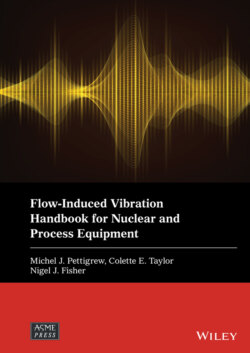Читать книгу Flow-Induced Vibration Handbook for Nuclear and Process Equipment - Группа авторов - Страница 38
Two‐Phase Flow
ОглавлениеWe have found that fluidelastic instability behavior is somewhat similar in continuous two‐phase cross flow, (Pettigrew et al, 1989b). As explained in Chapter 3, continuous flow means two‐phase flow regions of a continuous nature such as bubbly, spray, fog and wall flows as opposed to intermittent flow regimes leading to bundle reflooding and large flow oscillations. Such oscillations can lead to much lower critical velocity for fluidelastic instability (Pettigrew et al, 1989b, 1995 and 1994). Thus, intermittent flow regimes should be avoided in two‐phase cross flow.
Fig. 2-11 Summary of Fluidelastic Instability Data for Single‐Phase Cross Flow: Recommended Design Guidelines.
Fig. 2-12 Fluidelastic Instability Data in Two‐Phase Cross Flow.
Fluidelastic instability in two‐phase cross flow can also be formulated using Eq. (2-25). As shown in Fig. 2-12, a fluidelastic instability constant K = 3.0 is also recommended for two‐phase cross flow, but only for tube bundles of P/D > 1.47 which is the case for many steam generators. Lower values of K must be used for bundles of P/D ratios lower than 1.47, as discussed by Pettigrew and Taylor (1994). As shown in Fig. 2-13, the expression
(2‐26)
would be a reasonable design guideline for P/D < 1.47.
